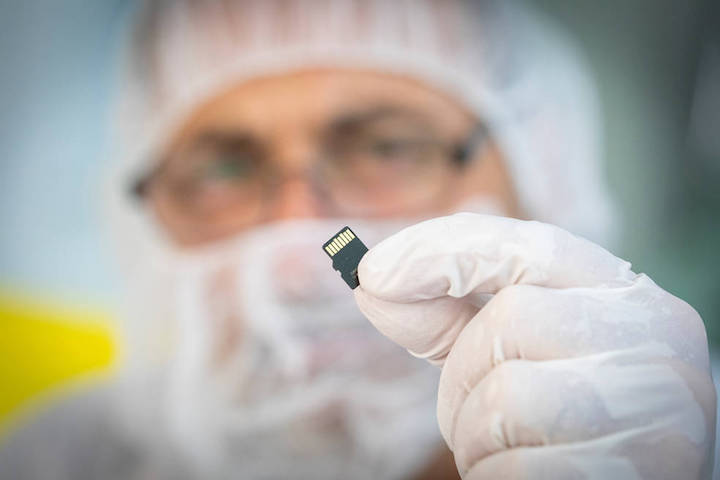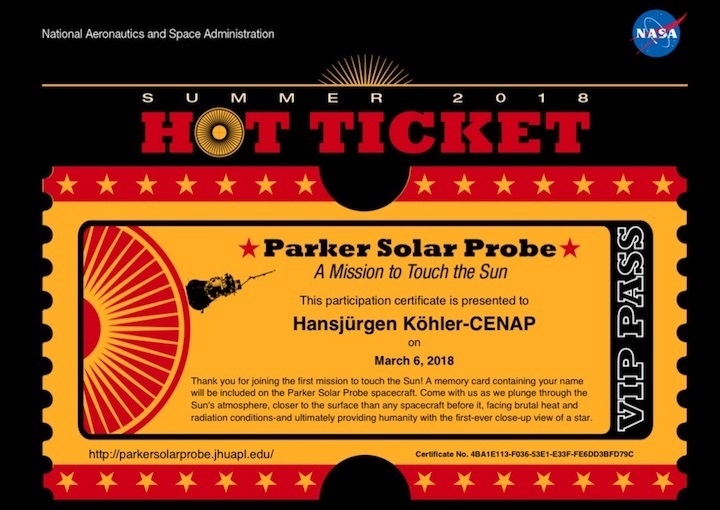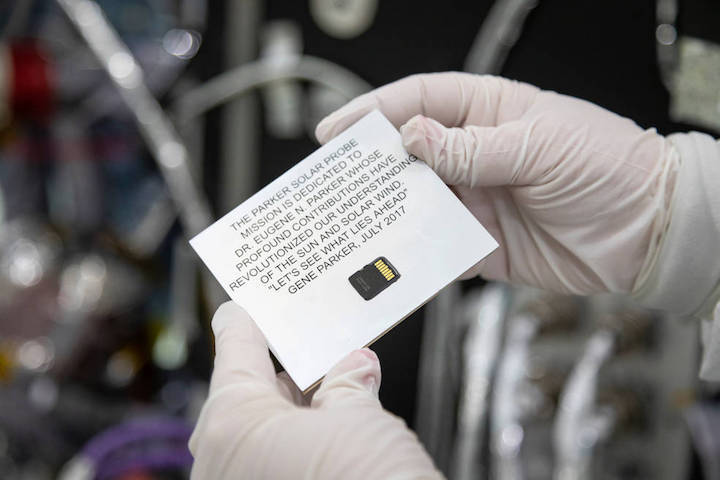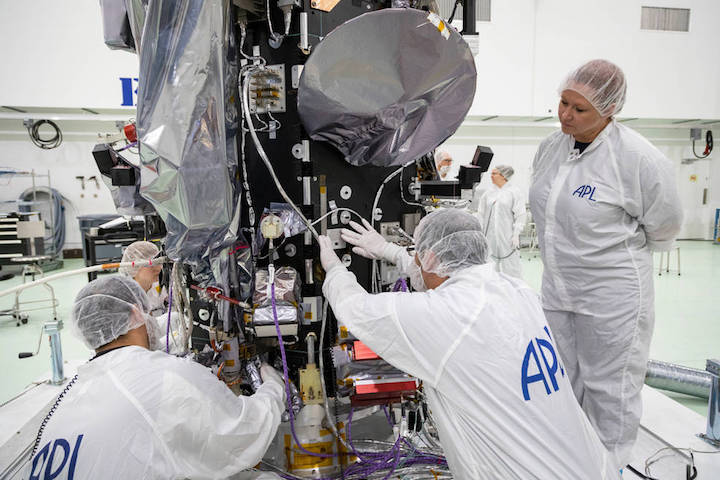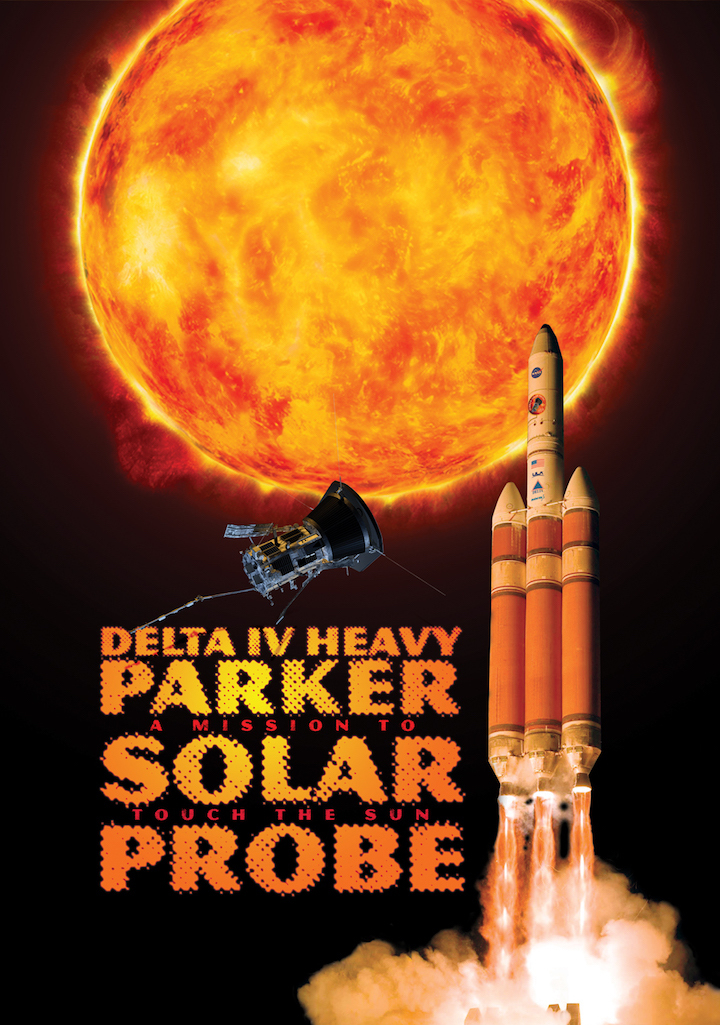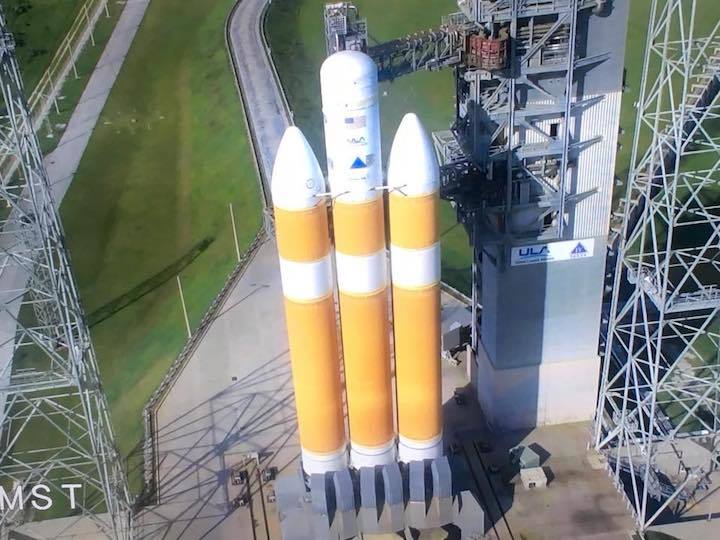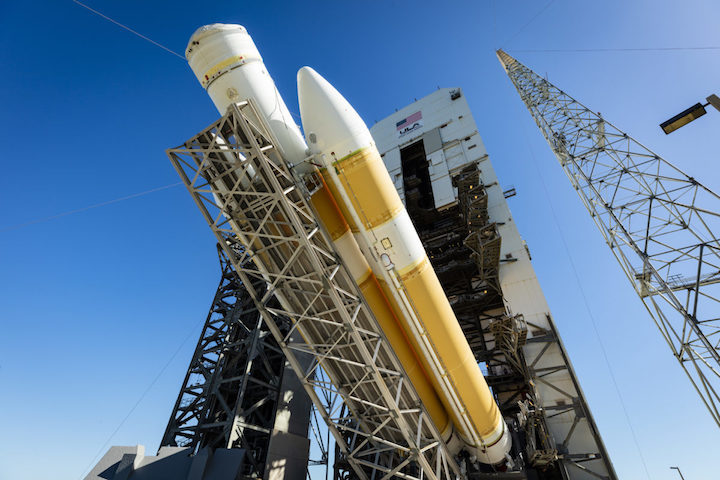23.05.2018

But in order to do this, the spacecraft demands an extremely high energy launch, and so the Delta IV Heavy’s capability will be augmented by a powerful third stage from Northrop Grumman Innovation Systems.
“Parker Solar Probe is going to revolutionize our understanding of the Sun, the only star we can study up close,” said Nicola Fox, project scientist for Parker Solar Probe at the Johns Hopkins Applied Physics Lab in Laurel, Maryland. “The mission undertakes one of the most extreme journeys of exploration ever tackled by a human-made object.”
The ultimate goal overall is to understand how the Sun works and how it affects the space environment, to the point of predictability. We’ll have more in-depth articles in the coming weeks on specifics about the science Parker Solar Probe will conduct, and how it will do so, including interviews with mission team members (so stay tuned).
The spacecraft itself is currently in a clean room at Astrotech Space Operations in nearby Titusville, Florida, where it arrived from NASA’s Goddard Space Flight Center in Greenbelt, Maryland on April 2, via a U.S. Air Force C-17 aircraft, for final comprehensive testing, assembly, fueling and mating to the Delta-IV Heavy’s thirst stage.
The spacecraft is expected to be transported to Launch Complex 37 to meet its rocket in mid-July.
Quelle: AS
---
Update: 9.07.2018
.
Cutting-Edge Heat Shield Installed on NASA’s Parker Solar Probe
The launch of Parker Solar Probe, the mission that will get closer to the Sun than any human-made object has ever gone, is quickly approaching, and on June 27, 2018, Parker Solar Probe’s heat shield — called the Thermal Protection System, or TPS — was installed on the spacecraft.
A mission 60 years in the making, Parker Solar Probe will make a historic journey to the Sun’s corona, a region of the solar atmosphere. With the help of its revolutionary heat shield, now permanently attached to the spacecraft in preparation for its August 2018 launch, the spacecraft’s orbit will carry it to within 4 million miles of the Sun's fiercely hot surface, where it will collect unprecedented data about the inner workings of the corona.
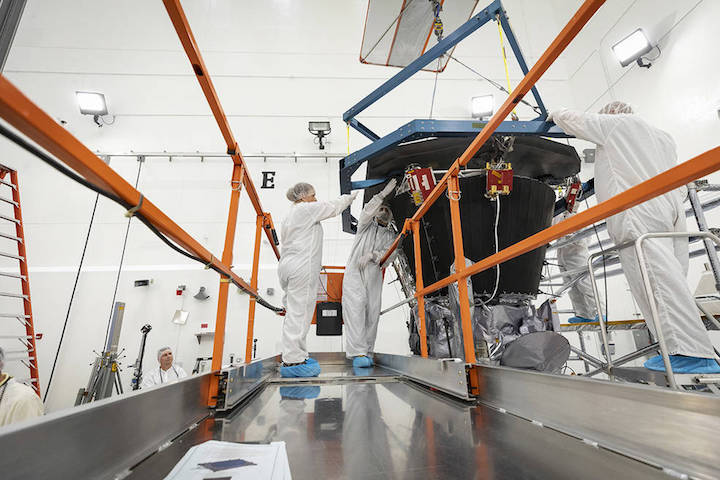
The eight-foot-diameter heat shield will safeguard everything within its umbra, the shadow it casts on the spacecraft. At Parker Solar Probe’s closest approach to the Sun, temperatures on the heat shield will reach nearly 2,500 degrees Fahrenheit, but the spacecraft and its instruments will be kept at a relatively comfortable temperature of about 85 degrees Fahrenheit.
The heat shield is made of two panels of superheated carbon-carbon composite sandwiching a lightweight 4.5-inch-thick carbon foam core. The Sun-facing side of the heat shield is also sprayed with a specially formulated white coating to reflect as much of the Sun’s energy away from the spacecraft as possible.
The heat shield itself weighs only about 160 pounds — here on Earth, the foam core is 97 percent air. Because Parker Solar Probe travels so fast — 430,000 miles per hour at its closest approach to the Sun, fast enough to travel from Philadelphia to Washington, D.C., in about one second — the shield and spacecraft have to be light to achieve the needed orbit.
The reinstallation of the Thermal Protection System — which was briefly attached to the spacecraft during testing at the Johns Hopkins Applied Physics Lab in Laurel, Maryland, in fall 2017 — marks the first time in months that Parker Solar Probe has been fully integrated. The heat shield and spacecraft underwent testing and evaluation separately at NASA’s Goddard Space Flight Center in Greenbelt, Maryland, before shipping out to Astrotech Space Operations in Titusville, Florida, in April 2018. With the recent reunification, Parker Solar Probe inches closer to launch and toward the Sun.
Parker Solar Probe is part of NASA’s Living with a Star Program, or LWS, to explore aspects of the Sun-Earth system that directly affect life and society. LWS is managed by Goddard for the Heliophysics Division of NASA’s Science Mission Directorate in Washington, D.C. The Johns Hopkins Applied Physics Laboratory manages the Parker Solar Probe mission for NASA. APL designed and built the spacecraft and will also operate it.
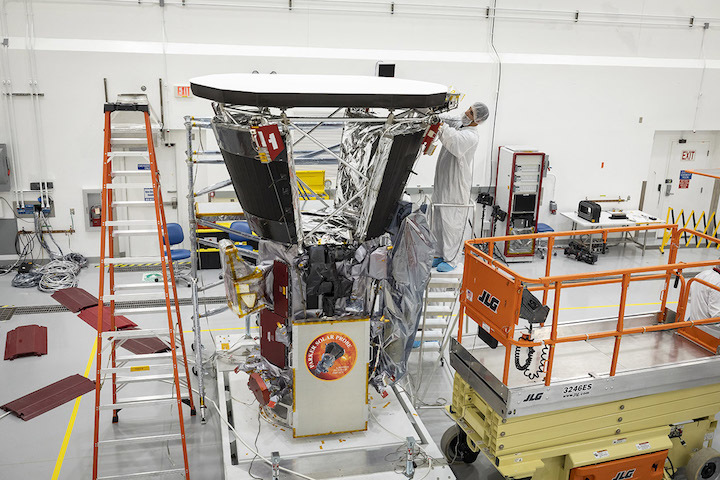
The Thermal Protection System connects to the custom-welded truss on the Parker Solar Probe spacecraft at six points to minimize heat conduction.
Quelle: NASA
----
Update: 17.07.2018
.
A LOOK BEHIND THE SCENES AT THE PARKER SOLAR PROBE
Videographer Lee Hobson and photographer Ed Whitman spend their days documenting mankind's mission to "touch" the sun
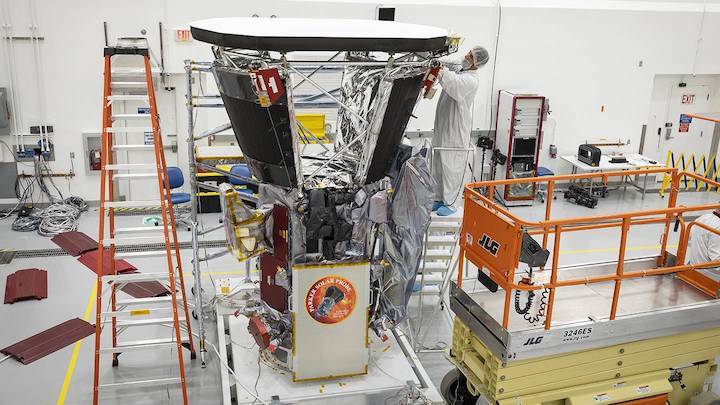
Lee Hobson and Ed Whitman flew to Florida in style three months ago, touching down in the Sunshine State in a Boeing C-17 loaded with priceless cargo: the Parker Solar Probe.
Hobson, director of photography for the Johns Hopkins Applied Physics Laboratory, is the video documentary lead for the APL-led mission to "touch" the sun. He and Whitman, APL's senior photographer, have spent the past four years painstakingly documenting the construction and testing of the probe, which is scheduled to launch in August. Flying through the sun's corona, or atmosphere, and facing heat and radiation like no spacecraft before it, the Parker Solar Probe will provide new data on solar activity and make critical contributions to scientists' ability to forecast major space-weather events that impact life on Earth.
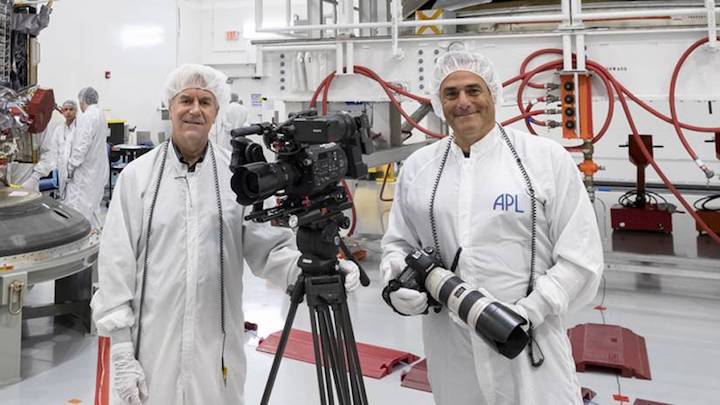
The Hub caught up with Hobson and Whitman to talk about their work, the mission, and what it's like to stand in the presence of the spacecraft that could change humanity's understanding of Earth's closest star.
How did you get involved with APL and documenting its projects?
Ed Whitman: As a kid, I was always fascinated with how things worked. There was nothing in my home that was safe from me and a screwdriver. I knew early on that I wanted to do photography, and I had my own company for many years, but when the opportunity at APL came up it just seemed like the right fit. I took the position and just loved it because, you know, I'm basically a frustrated engineer.
Lee Hobson: I joined in 1988 as a staff photographer and then moved into the video sector in 1996. On any given day I could be working in air defense or force projections, or national security analysis and research, or of course space exploration. That's what's really cool about APL—there's a lot of different things we work on.
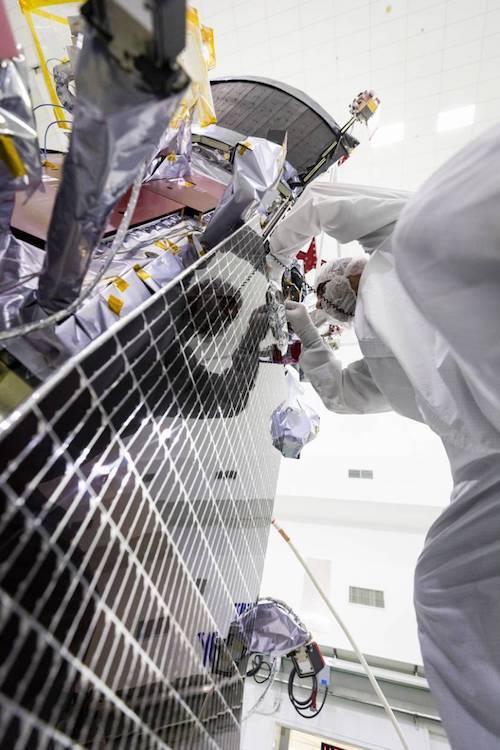
What's it like to document the Parker Solar Probe?
LH: The average day is about 10 hours here, but it's sometimes as long as 15 hours depending on what we're doing. Ed and I are unique in that when the day's operation is finished, we don't go home, we come back to the office to edit footage. So it can be a really long day.
EW: We do press releases for the public, and those are more like the milestone events when significant things happen. But day to day, I'm working with the mechanical team, shooting everything that's being integrated into the spacecraft—every nut, every bolt, every process that takes place. And that's helpful because if the mechanical team gets a faulty software reading or a piece of hardware that's not functioning properly, they can go back through our photos and images and diagnose the problem.
VIDEO: LEE HOBSON / JOHNS HOPKINS APPLIED PHYSICS LABORATORY
What's been your favorite experience documenting the Solar Probe?
LH: I've really enjoyed writing and editing the Solar 60 video series. I wanted to come up with a way of telling a story through the eyes of our different technicians and scientists and engineers. They get to be the reporters, and they have great camera presence, and I get to be the producer and script writer. So that's a lot of fun, getting to tell those stories. And, of course, the access that I have to the spacecraft. I mean, we're working next to the spacecraft that's going to fly within 4 million miles of the sun, and I get to walk around the launchpad. So that's really cool.
EW: For me, it's interesting to see the process of building something that's so highly engineered and thought out but is still a one-off that's never been built before. And I got to integrate my photography with the mechanical team for a test they needed to conduct: They had to lift the spacecraft way up in the sky and then drop down this magnetometer boom, and they had to do it really carefully so they could see how things were working. As it was coming down, I was walking around taking photos in 360 degrees, and I was shooting the photos to the lead engineer using my iPad. I mean, this $2 billion spacecraft is dangling from this lift in front of me and from my photos, the engineer can see the boom harness and determine the clearance and how it interacts with the spacecraft.
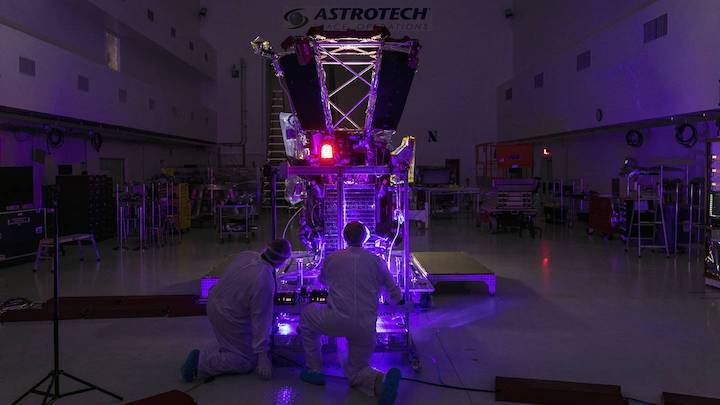
Engineers created a bank of lasers to test the solar arrays that will power the spacecraft. "When we turned off the lights, magical things happened," says Whitman. "Reflections and a purple glow everywhere... Visually, it was really incredible."
-
What's the most surprising thing about your work with the Solar Probe?
EW: The spacecraft is so light! It's only 1,500 pounds, and it's being launched in literally the biggest launch vehicle ever built, the Delta IV Heavy. It's a monster! It stands in front of you like a building. You feel so tiny and insignificant when you look at it, and the spacecraft—they call it a hood ornament—it's this tiny thing in this giant housing, but those are the things that are going to fall away during launch. It's just mind-boggling to me.
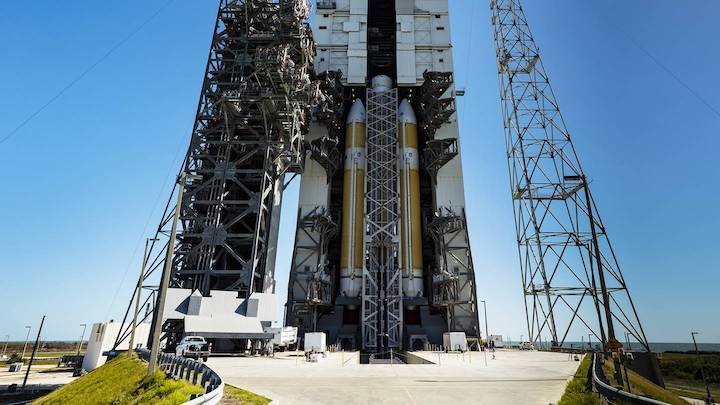
"[The spacecraft is] being launched in literally the biggest launch vehicle ever built, the Delta IV Heavy. It's a monster! It stands in front of you like a building," says Whitman.
-
How do you think you'll feel when the Parker Solar Probe finally launches?
EW: I'll feel probably sad and elated. Happy that I was part of something that's just so awesome, but sad in the sense that I don't want it to end because it's just so exciting and so interesting.
LH: I'm always really proud when we have a successful launch, and we've gotten that telemetry maybe 20 minutes after launch that means it survived and that the engineers built a really good spacecraft. But also I'll feel really proud when we start to get the data sent back. I mean, the Parker Solar Probe is going to rewrite the textbooks with new information about the sun and the corona, and I've touched it—the spacecraft that's going to fly around our sun and give scientists information that they never knew before. That's really exciting.
Quelle: Johns Hopkins University
---
Update: 21.07.2018
.
NASA Prepares to Launch Parker Solar Probe, a Mission to Touch the Sun
NASA's First Spacecraft to 'Touch the Sun' Ready For August 6 Launch on Delta IV Heavy
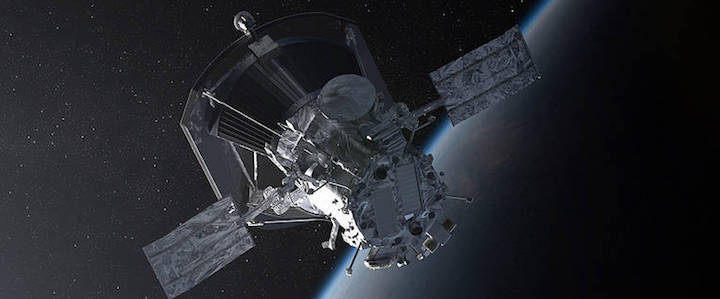
Our Sun is far more complex than meets the eye. Rather than the steady, unchanging disk it seems to human eyes, the Sun is a dynamic and magnetically active star. The Sun's atmosphere constantly sends magnetized material outward, enveloping our solar system far beyond the orbit of Pluto and influencing every world along the way. Coils of magnetic energy can burst out with light and particle radiation that travel through space and create temporary disruptions in our atmosphere, sometimes garbling radio and communications signals near Earth. The influence of solar activity on Earth and other worlds are collectively known as space weather, and the key to understanding its origins lies in understanding the Sun itself.
“The Sun’s energy is always flowing past our world,” said Fox. “And even though the solar wind is invisible, we can see it encircling the poles as the aurora, which are beautiful – but reveal the enormous amount of energy and particles that cascade into our atmosphere. We don’t have a strong understanding of the mechanisms that drive that wind toward us, and that’s what we’re heading out to discover.”
That's where Parker Solar Probe comes in. The spacecraft carries a lineup of instruments to study the Sun both remotely and in situ, or directly. Together, the data from these state-of-the-art instruments should help scientists answer three foundational questions about our star.
One of those questions is the mystery of the acceleration of the solar wind, the Sun's constant outflow of material. Though we largely grasp the solar wind's origins on the Sun, we know there is a point – as-yet unobserved – where the solar wind is accelerated to supersonic speeds. Data shows these changes happen in the corona, a region of the Sun's atmosphere that Parker Solar Probe will fly directly through, and scientists plan to use Parker Solar Probe's remote and in situ measurements to shed light on how this happens.
Second, scientists hope to learn the secret of the corona's enormously high temperatures. The visible surface of the Sun is about 10,000 F – but, for reasons we don't fully understand, the corona is hundreds of times hotter, spiking up to several million degrees F. This is counterintuitive, as the Sun's energy is produced at its core.
"It's a bit like if you walked away from a campfire and suddenly got much hotter," said Fox.
Finally, Parker Solar Probe's instruments should reveal the mechanisms at work behind the acceleration of solar energetic particles, which can reach speeds more than half as fast as the speed of light as they rocket away from the Sun. Such particles can interfere with satellite electronics, especially for satellites outside of Earth's magnetic field.
To answer these questions, Parker Solar Probe uses four suites of instruments.
The FIELDS suite, led by the University of California, Berkeley, measures the electric and magnetic fields around the spacecraft. FIELDS captures waves and turbulence in the inner heliosphere with high time resolution to understand the fields associated with waves, shocks and magnetic reconnection, a process by which magnetic field lines explosively realign.
The WISPR instrument, short for Wide-Field Imager for Parker Solar Probe, is the only imaging instrument aboard the spacecraft. WISPR takes images from of structures like coronal mass ejections, or CMEs, jets and other ejecta from the Sun to help link what’s happening in the large-scale coronal structure to the detailed physical measurements being captured directly in the near-Sun environment. WISPR is led by the Naval Research Laboratory in Washington, D.C.
Another suite, called SWEAP (short for Solar Wind Electrons Alphas and Protons Investigation), uses two complementary instruments to gather data. The SWEAP suite of instruments counts the most abundant particles in the solar wind — electrons, protons and helium ions — and measures such properties as velocity, density, and temperature to improve our understanding of the solar wind and coronal plasma. SWEAP is led by the University of Michigan, the University of California, Berkeley, and the Smithsonian Astrophysical Observatory in Cambridge, Massachusetts.
Finally, the ISʘIS suite – short for Integrated Science Investigation of the Sun, and including ʘ, the symbol for the Sun, in its acronym – measures particles across a wide range of energies. By measuring electrons, protons and ions, ISʘIS will understand the particles’ lifecycles — where they came from, how they became accelerated and how they move out from the Sun through interplanetary space. ISʘIS is led by Princeton University in New Jersey.
Parker Solar Probe is a mission some sixty years in the making. With the dawn of the Space Age, humanity was introduced to the full dimension of the Sun's powerful influence over the solar system. In 1958, physicist Eugene Parker published a groundbreaking scientific paper theorizing the existence of the solar wind. The mission is now named after him, and it's the first NASA mission to be named after a living person.
Only in the past few decades has technology come far enough to make Parker Solar Probe a reality. Key to the spacecraft's daring journey are three main breakthroughs: The cutting-edge heat shield, the solar array cooling system, and the advanced fault management system.
“The Thermal Protection System (the heat shield) is one of the spacecraft’s mission-enabling technologies,” said Andy Driesman, Parker Solar Probe project manager at the Johns Hopkins Applied Physics Lab. “It allows the spacecraft to operate at about room temperature."
Other critical innovations are the solar array cooling system and on-board fault management systems. The solar array cooling system allows the solar arrays to produce power under the intense thermal load from the Sun and the fault management system protects the spacecraft during the long periods of time when the spacecraft can’t communicate with the Earth.
Using data from seven Sun sensors placed all around the edges of the shadow cast by the heat shield, Parker Solar Probe's fault management system protects the spacecraft during the long periods of time when it can't communicate with Earth. If it detects a problem, Parker Solar Probe will self-correct its course and pointing to ensure that its scientific instruments remain cool and functioning during the long periods when the spacecraft is out of contact with Earth.
Parker Solar Probe's heat shield – called the thermal protection system, or TPS – is a sandwich of carbon-carbon composite surrounding nearly four and half inches of carbon foam, which is about 97% air. Though it's nearly eight feet in diameter, the TPS adds only about 160 pounds to Parker Solar Probe's mass because of its lightweight materials.
Though the Delta IV Heavy is one of the world’s most powerful rockets, Parker Solar Probe is relatively small, about the size of a small car. But what Parker Solar Probe needs is energy – getting to the Sun takes a lot of energy at launch to achieve its orbit around the Sun. That's because any object launched from Earth starts out traveling around the Sun at the same speed as Earth – about 18.5 miles per second – so an object has to travel incredibly quickly to counteract that momentum, change direction, and go near the Sun.
The timing of Parker Solar Probe's launch – between about 4 and 6 a.m. EDT, and within a period lasting about two weeks – was very precisely chosen to send Parker Solar Probe toward its first, vital target for achieving such an orbit: Venus.
“The launch energy to reach the Sun is 55 times that required to get to Mars, and two times that needed to get to Pluto,” said Yanping Guo from the Johns Hopkins Applied Physics Laboratory, who designed the mission trajectory. “During summer, Earth and the other planets in our solar system are in the most favorable alignment to allow us to get close to the Sun.”
The spacecraft will perform a gravity assist to shed some of its speed into Venus' well of orbital energy, drawing Parker Solar Probe into an orbit that – already, on its first pass – carries it closer to the solar surface than any spacecraft has ever gone, well within the corona. Parker Solar Probe will perform similar maneuvers six more times throughout its seven-year mission, assisting the spacecraft to final sequence of orbits that pass just over 3.8 million miles from the photosphere.
“By studying our star, we can learn not only more about the Sun,” said Thomas Zurbuchen, the associate administrator for the Science Mission Directorate at NASA HQ. “We can also learn more about all the other stars throughout the galaxy, the universe and even life’s beginnings.”
Parker Solar Probe is part of NASA’s Living with a Star Program, or LWS, to explore aspects of the Sun-Earth system that directly affect life and society. LWS is managed by NASA’s Goddard Space Flight Center in Greenbelt, Maryland, for the Heliophysics Division of NASA’s Science Mission Directorate in Washington. Johns Hopkins APL manages the Parker Solar Probe mission for NASA. APL designed and built the spacecraft and will also operate it.
Quelle: NASA
----
Update: 22.07.2018
.
NASA’s Parker Solar Probe will ‘shake’ hands with sun, thanks to small push from Venus
Sending a spacecraft from Earth to a stationary target like the sun is like trying to throw a dart from a speeding train. That’s because Earth is barreling through space at 19 miles per second, or 67,000 miles per hour. No matter how fast we try to shoot the probe into space, its momentum will cause it to keep orbiting the sun.
In early August, NASA will take on this challenge when it launches the Parker Solar Probe — a mission to fly seven times closer to the sun than any other spacecraft has before.
Like Icarus of Greek mythology, the journey is a daring flight into the unknown. But NASA scientists must strike the perfect balance between flying just close enough that the spacecraft can collect the data it needs but not so close that it burns up. Here’s what the mission will take.
The Venus effect
Yanping Guo is the mission designer for the probe. She has worked for the past 16 years to create a flight path for the mission at the Johns Hopkins University Applied Physics Laboratory, where the probe was designed and built.

Yanping Guo is the mission designer for the Parker Solar Probe. She and her team have mapped a journey that will bring the probe into the sun’s corona. Photo by Johns Hopkins APL/Ed Whitman
“You might think getting to the sun is easy because it’s not far and you can see it,” she said. “But of all the solar system explorations, it’s the most challenging.”
The only way to get it close, Guo figures, is to slow the Parker Solar Probe way down, so it can achieve tighter orbits around the sun. To do that, the 1,400-pound probe will get a little help from Venus. The probe will fly just close enough to Venus so that it will get pulled toward the surface, allowing it to slow down and change its path–this is called a gravity assist.
Over the next seven years, as it circles the sun, the probe will wrap around Venus seven times, each time slowing down and swooping closer to the sun. In seven years, the probe will be within four million miles of the sun’s surface. In space terms, that’s practically shaking hands.
Guo has employed this tactic of using other planets to help move spaceships in the past. For instance, she used Jupiter to propel the New Horizons mission to Pluto. But using the same planet seven times? That’s completely new, and there’s a lot to keep track of.
“To achieve the flyby, you have to know how fast you’re moving, where the orbit is, where Venus is,” Guo said. “You have to have it all sorted out, predicted precisely, and timed exactly to be in the right place at the right time.”
Every inch closer to the sun means the probe will be exposed to more excruciating heat and radiation. At its closest pass, in December 2024, the probe will be subjected to 2,500 degrees Fahrenheit — which is toasty but still pales in comparison to solar flares that reach tens of millions of degrees. The probe will be flying straight through coronal plasma, which is electrified gas that shoots out from the sun’s surface, hoping to miss these super hot flares. (Don’t worry, the chances of hitting a flare are low.)
Thanks to a state-of-the-art carbon-carbon heat shield, the Parker Solar Probe’s instruments will be kept at room temperature if everything goes as planned.
“Whatever we think the worst case could possibly be, we are designed and built to withstand a lot worse than that,” said Nicola Fox, project scientist for the probe mission, also at Johns Hopkins.

The probe, including its carbon-carbon heat shield, is only about 10 feet tall. Its light weight and small stature make it easier to shoot into space. Photo by NASA/Johns Hopkins APL/Ed Whitman
What Parker is probing
After all, getting close to the sun is the whole point. The probe will take scientists into the solar corona–the sun’s atmosphere. Nicholeen Viall is a solar scientist at NASA who is anxiously awaiting data from the probe to answer questions that have eluded scientists for years.
One thing on Viall’s mind is what she calls the counterintuitive “coronal heating problem,” a phenomenon in which the sun’s atmosphere is hundreds of times hotter than the sun’s surface. That’s like walking away from a normal fireplace and suddenly being subjected to 100,000 degree temperatures.
Scientists know that the phenomenon has something to do with the interaction between the sun’s heat and magnetic waves, but no one knows exactly what is happening.

Illustration of the Parker Solar Probe spacecraft approaching the Sun. Image by NASA/Johns Hopkins APL/Steve Gribben
“With the probe, we get to stick a thermometer and a magnetic field sensor into the sun right as these very energetic processes happen,” said Viall, who wasn’t involved with the mission. “These are new measurements we’ve never been able to make before.”
A close look at the sun’s magnetic field will also shine light on the origins of solar wind–that’s the charged gas that comes off the sun and bombards Earth. Our planet’s magnetic field wards off this radiation.
Quelle: PBS
---
Update: 24.07.2018
.
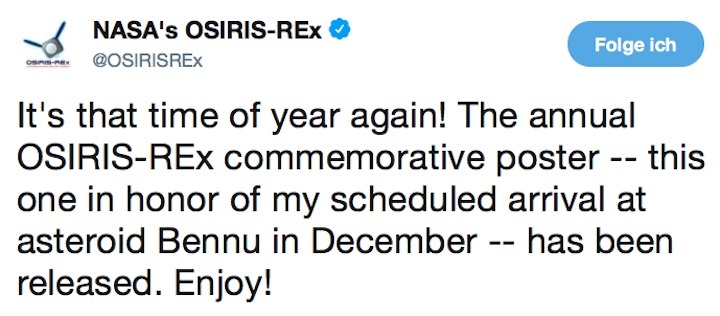
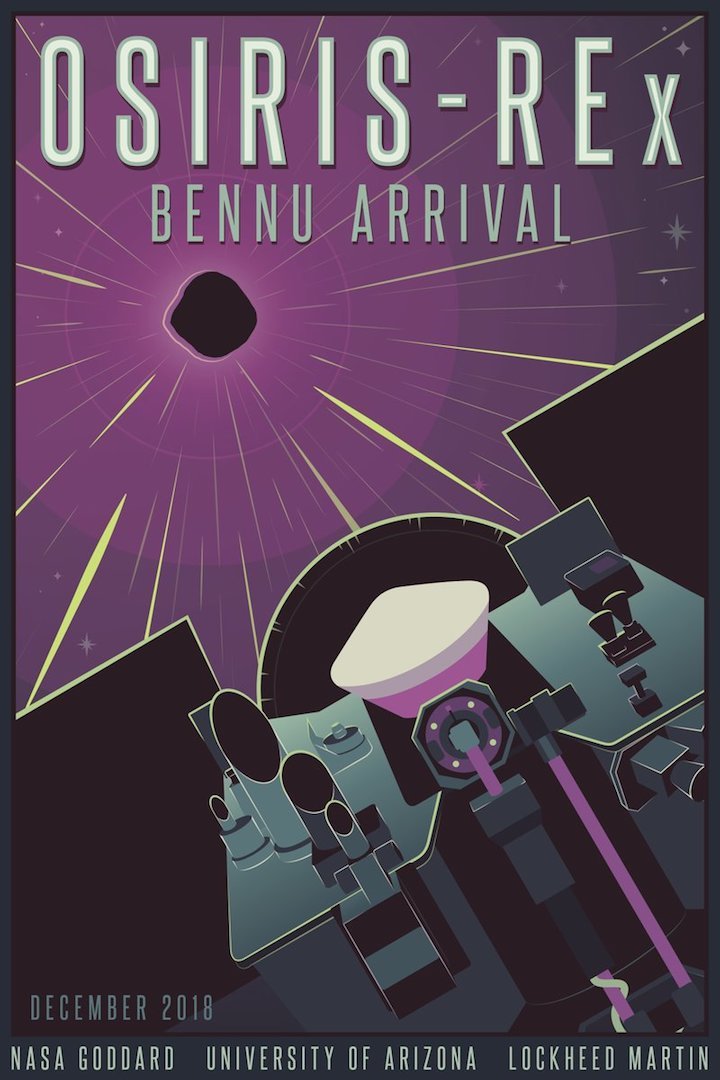
Quelle: NASA
---
Update: 25.07.2018
.
Parker Solar Probe Launch Targeted for Aug. 11
NASA and its mission partners are targeting Aug. 11 for the launch of the Parker Solar Probe mission to the Sun. The 45-minute launch window will open at 3:48 a.m. EDT. During final inspections following the encapsulation of the spacecraft, a small strip of foam was found inside the fairing and additional time is needed for inspection.
The spacecraft will launch on a United Launch Alliance Delta IV Heavy rocket from Space Launch Complex 37 on Cape Canaveral Air Force Station in Florida.
Quelle: NASA


